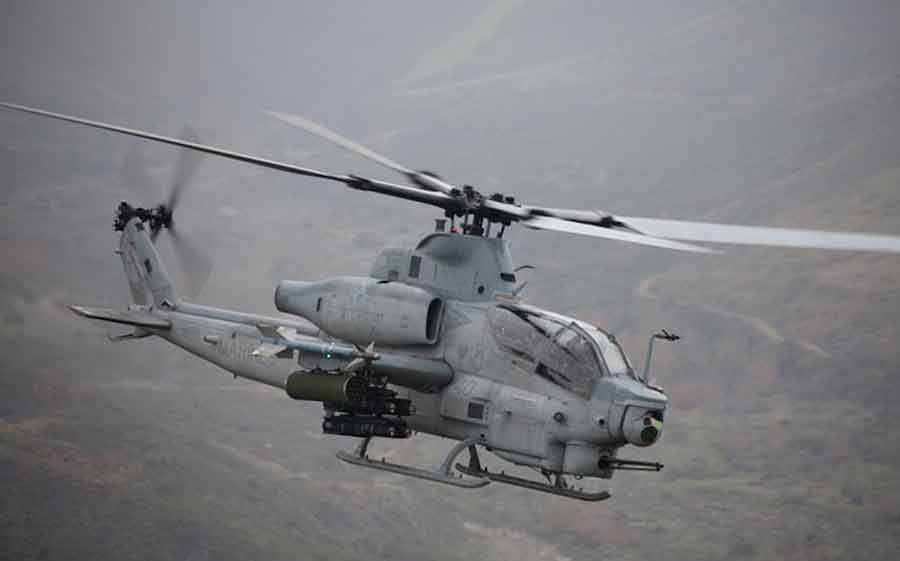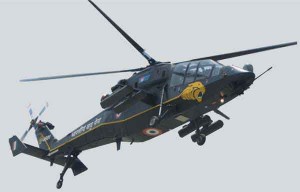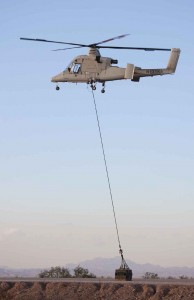The Russians have also developed the state-of-the-art AH in the Ka-50 (Hokum) and MI-28 (Havoc). This decision was taken after their experience in Afghanistan with the MI-24 AH, which was basically an armed helicopter and hence not suited for a typical AH role. The Ka-50 is the world’s first coaxial, single-seat AH. The MI-28, on the other hand, is roughly equivalent to the Apache Longbow but without the command-and-control link up. The MI-28 has a 30mm chain gun, Ataka anti-tank missiles and pods for S-8 and S-13 rockets. The Ataka is an improved version of the Vikhr anti-tank guided missile fitted on the MI-25/MI-35 AH. It also has in its armament the Igla/Vympel air-to-air missiles. The other dedicated AH operating in the environment are the Italian Augusta Westland AW129 Mangusta, Bell Helicopter’s Viper, the latest version of Huey Cobra, Eurocopter’s Tiger and the latest formidable entry the Chinese Z-10 Zhising. As per reports, China is also in the process of developing another AH, the Z-19, the prototype having flown in December 2010.
The MI-28 is roughly equivalent to the Apache Longbow but without the command-and-control link up.
Multi-Role Concept
The multi-role concept for helicopters evolved during the Vietnam War but was subsequently taken over by the requirement of dedicated AH as an anti-armour/anti-tank weapon system. However, the nature of war has undergone a major change in the last few years with emphasis on non-conventional operations. World over the armed forces are now seriously looking at this concept and the requirement of MRH especially for counter-insurgency and counter-terrorist operations. The MRH is basically a utility/troop carrying helicopter with inbuilt provisions for fitment of armament. The MRH can be fielded for roles such as ground attack, air assault, cargo, surveillance and troop transport. The size of such helicopters is generally between that of cargo and light observation helicopters. The basic armament would generally be restricted to guns and rockets. However, air-to-ground and air-to-air missiles are also reported to be a part of armament of some MRH primarily putting them in the class of armed helicopters. All these helicopters are also fitted with self-protection suite with missile approach warning system, threat warning equipment and chaffs/flare dispensers. Some of the MRH in service in different countries are US marine Bell UH-IN Twin Huey, Augusta Westland AW-139, German Army’s NH-90, US Army’s UH-60 Black Hawk and Russian MI-17(all versions). With its experience in Afghanistan, the US has embarked on a programme for developing four variants of different sizes of MRH. In our context, we have the MI-17 IV/V, Navy’s Sea King and the Advanced Light Helicopter (ALH) in this category.
Indian Scenario
The ALH, also known as the Dhruv, is already in service with the armed forces. The weaponised version of the ALH called the ALH Weapons Systems Integrated (ALH WSI) or RUDRA, has formally been handed over to the army in February this year and induction is likely to commence soon. The RUDRA is fitted with the more powerful Shakti engine being manufactured by Hindustan Aeronautics Ltd (HAL) in collaboration with French Turbomeca. This engine has also been evaluated for high altitude operations on the ALH. Basically, the RUDRA is a new generation armed helicopter duly modified for fitment of all types of weapon sub-systems carried by a modern day AH. The RUDRA has a 20mm gun turret, 70mm rockets and the Mistral air-to-air missile. However the anti-tank missile Helina, the air version of NAG being developed by the Defence Research and Development Organisation (DRDO) is still not ready. Once developed, the Helina will be a fire-and-forget missile with a seven-kilometre range and would compare with the Hellfire missile. To meet the interim requirement the Army has already carried out trials for a suitable anti-tank missile and in contention are the French PARS-3 and Israeli SPIKE-ER. Decision by the MoD on the selection is awaited.
The HAL has also embarked on the development of the Light Combat Helicopter (LCH). The LCH employs the technology of the ALH except the fuselage which is streamlined and suitably modified for tandem-seating of pilot and weapons system operator with adequate armour protection. The weapons and systems will be similar to the RUDRA. This approach has an inherent advantage as most of the critical systems have been proven either on the ALH or the RUDRA. An indigenous AH like the LCH is a step in the right direction as it can be tailored to suit the terrain and climatic conditions of our area of operations, especially high altitude operations. The first flight of LCH took place on March 29, 2010, and the AH is likely to enter service by 2014. Once fielded, the LCH should compare well with Eurocopter’s Tiger, Italian Mangusta and Bells Huey Cobra as it is in the same weight category.
The ALH, also known as the Dhruv, is already in service with the armed forces.
In the MRH class, the Navy is already looking at replacing its vintage Sea King fleet. In the fray are the US S-70 Bravo and Eurocopter’s NH-90, though this process has been stalled for now. The HAL is also looking at the development of a 10-12 tonne class of MRH for the requirement of the armed forces in a joint venture with a foreign manufacturer. However, no progress has been made in this project so far. The Army is keen to acquire this class of helicopters and has suitably called it the Tactical Battlefield Support Helicopter (TBSH). This will enhance its lift capability in the Tactical Battle Area as well as be the frontline helicopter for Special Operations.
Future Development
While jet fighters are in their fifth generation, helicopters are still languishing with the same old airframes for the last several decades, with mostly upgrades to their credit. The APACHE AH-64E Block-III is a vivid example of the same even though 26 new technologies have been incorporated in the upgraded version. However, the new generation helicopter platforms are now featuring the latest advances in aeronautics giving military helicopters improved flight performance as well as weapon systems with incremental technological and technical upgrades. This offers the new generation machines unprecedented capabilities – lighter and stronger materials of construction, increased autonomy, more powerful engines, reduced acoustic signatures, more accurate navigation systems, enhanced data acquisition and protection systems, and more effective weapons and munitions. Designed as weapon systems integrating multiple functions, helicopters will have to become truly modular, making it possible to replace components without affecting overall integrity. The concept of modularity is likely to increase, especially with the emergence of multi-role machines.
The HAL has also embarked on the development of the Light Combat Helicopter (LCH).
In terms of data acquisition – day/night observation and detection capabilities will increase and become more diversified specially in respect of information-sharing and cooperation with other aircraft and UAVs. Target engagement capabilities with regard to weapon range and precision is likely to remain the focus of future development. With sub-conventional operations gaining ascendency around the world, helicopter survivability will assume greater significance. Advances in stealth, such as reductions in radar and acoustic signatures, offer major results in this area, as does the development of early detection/jamming counter-measure capabilities. Aerial navigation today has become an art which nears perfection. External navigation aids and onboard systems help navigate an aircraft over thousands of miles with such accuracy that could only be imagined a few decades ago. Pilots today have various navigation aids that help them take-off, fly and land safely. These include the Inertial Guidance System, Long Range Navigation (LORAN), GPS, Weather Radar, Terrain Collision Avoidance System (TCAS) and the Terrain Awareness Warning System (TAWS). The TAWS is very significant for the combat helicopters which most of the time have to fly very low in the Nap-of-the-Earth mode during operations.
Some of the above technologies are already being incorporated in the development of Eurocopter’s X2 and X3 and Sikorsky’s X2 co-axial compound helicopter as technology demonstrators. The main emphasis is on speed, stealth, reliability and survivability. In fact, in its demonstrative flight Sikorsky’s X2 achieved a speed of 287mph a major leap from the current standard helicopter speeds. Its military version the Sikorsky ‘S-97 Raider’ is stated to be the future light tactical helicopter of the US Military. Finally, the development of innovative concepts along the lines of V-22 Osprey tilt rotor technology, could generate fresh momentum in the utility/logistics domain. The V-22 is already deployed in Afghanistan and was instrumental in the rescue of a downed US pilot in Libya last year. The US is looking at a joint heavy-lift Rotorcraft platform designed to enter service by 2030.
Another area of future development is helicopter UAVs. Two avenues are already being explored and implemented in different countries – UAV-helicopter cooperation and development of rotary wing UAVs. Lockheed Martin’s K-MAX helicopter UAV is currently deployed in Afghanistan for logistics support and has proved to be successful. It has been able to fly in adverse weather wherein manned helicopters could not fly – armed forces may be looking at the armed version of the K-MAX.
Conclusion
Combat helicopters whether armed, dedicated AH or MRH will be extremely relevant in future conflicts especially in sub-conventional operations. The battle-proven Apaches from their anti-tank role in Iraq were employed in support of the infantry against the Taliban in Afghanistan. The MRH will continue to play a pivotal role in future conflicts, more so in Special Operations. With the RUDRA and the LCH being indigenously developed by HAL and likely to enter service in the coming years, the Indian armed forces will have formidable state-of-the-art combat helicopters in their inventory – a weapon system that will have capability to turn the tide in battle.







